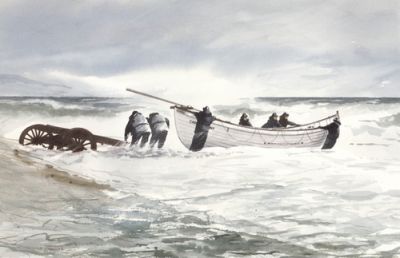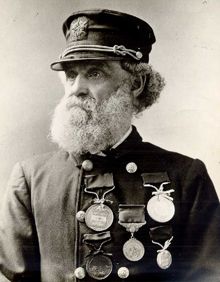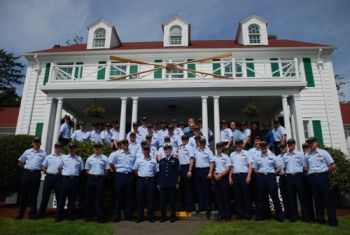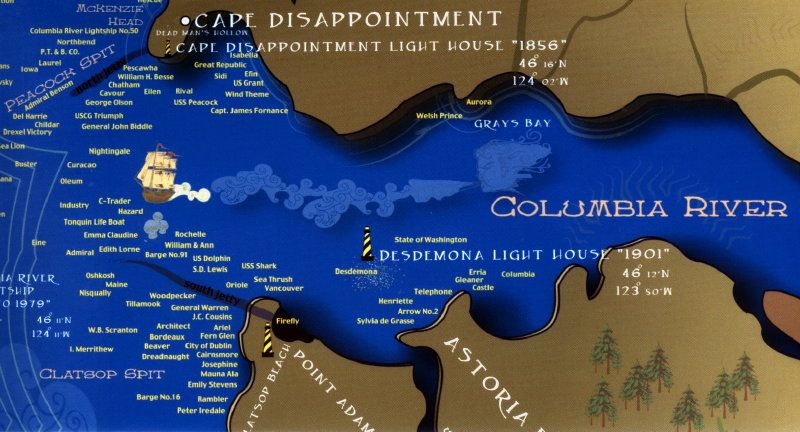
Publisher:
Bonnie King
CONTACT:
Newsroom@Salem-news.com
Advertising:
Adsales@Salem-news.com

~Truth~
~Justice~
~Peace~
TJP
Apr-16-2010 13:13

 TweetFollow @OregonNews
TweetFollow @OregonNews
A Surfman's Legacy
Levi Read Special to Salem-News.comPerils and rewards of the daily life of the U.S. Coast Guard.
 Photos and video supplied by U.S. Coast Guard |
(BODEGA BAY, Calif.) - When someone trains for anything in life, they train to be ready when it really counts. When it counts, when a life is on the line, everybody wants a hero that has trained in that exact scenario.
For this reason, Coast Guardsmen train in real-life situations so they are ready when it really counts. When your training ground is as vast and as powerful as the ocean, every training operation can turn into a life and death scenario.
Late last year, a boat crew, from Coast Guard Station Bodega Bay, found itself in this type of training scenario. During a session Station Bodega Bay surf drills aboard a 47-foot Motor Lifeboat, the crew was training in surf conditions that consisted of 15-foot breaking waves. One of these waves caused a knockdown of the boat. Soon the crew was surrounded by the roaring water and were in a perilous position as the ocean pounded its cold, brute force down upon them. But the cool hand at the helm and controls saved his crew and his own life by skillfully maneuvering out of harm’s way.
The Coast Guard is best known for its members' legendary status as search and rescue heroes – saving more than 1 million lives. An elite community within the Coast Guard with a legacy that may be second-to-none has played a big part in that number... These men and women have earned the title of Coast Guard surfmen.
U.S. Coast Guard Station Bodega Bay surf drills |
There are only 20 designated surf stations in the Coast Guard, of which 15 are located on the West Coast. Surf stations are designated in areas where surf greater than eight feet occurs ten percent or more days during a calendar year (36 days) averaged over a minimum period of five years. At these stations reside some of the best and most experienced small boat operators, designated as surfmen because of their ability to operate motor lifeboats in the maximum weather conditions the boats were designed for. The 47-foot MLB is designed to operate in up to 30-foot seas, 20-foot surf and 50-mph winds. The 52-foot MLB is designed to operate in up to 35-foot seas, 25-foot surf and 80-mph winds.
“The best of the best boat operators are surfmen,” said Petty Officer 1st Class Jay Nilles, surfman #338 and law enforcement officer at Station Bodega Bay. “I believe the surfman program compares favorably to the Navy’s Top Gun program.”
Surfmen are trained on the job through hands-on experience. The most important job a surfman has is the responsibility to keep himself and his crew safe. For this reason, every member of the boat crew must wear helmets, dry suits, lifejackets, and other safety gear including signaling devices. The crewmembers are strapped into the boat by clips that are connected to a heavy-duty belt that is worn tightly around the waist.
When a wave approaches, the MLB should be positioned facing into the wave. The boat operator controls the throttles in various ways depending on the type, size, power and position of the wave. On many occasions, the crew is staring up at a wave as the boat maneuvers into and through it. The crew must brace itself for the impact of the cold, salty water as it crashes upon them during the descent down the back of the wave.
“Surfmen make up an elite and tight community that only grows stronger each time one of us goes out with our crews to rescue sailors in peril,” said Chief Petty Officer Erik Watson, surfman #336 and Executive Officer of Coast Guard Station Bodega Bay. “My family gives me the strength to do what I need to do; to come home safely. Search and rescue only counts if everyone comes home safely.”
The National Motor Lifeboat School, in Ilwaco, Wash., near the mouth of the Columbia River, is an ideal training ground for future surfmen. The NMLBS is the only school in the world for rough weather surf rescue operations.
The area around the mouth of the Columbia River, located between Oregon and Washington, is known as the "Graveyard of the Pacific," because more than 2,000 ships are known to have sunk in the area. The locale is an ideal rough weather training environment because of the river’s deep water channel, rock jetties, coastal surf zones, and waves that can often exceed 20 feet.
Although there is no school that can certify a person as a surfman, up to 150 students attend courses at the NMLBS every year. In addition to U.S. Coast Guard students, the Canadian Coast Guard, the Royal National Lifeboat Institute, Norway, and other countries have sent students through the course.
There are many characteristics that a surfman must have to be successful including humility, courage, and dedication. Becoming a surfman takes years of apprenticeship. The average surfman apprenticeship is five years, starting from the time they become a coxswain to when they are pinned a surfman. The process starts by first becoming boat crew qualified, which on average takes about six months. Then they train for another six months to become coxswain qualified. After the coxswain qualification, they will train to gain a heavy weather qualification, along the way to earning the surfman qualification.
“The pinning of the surfman is the start of the learning process, not the culmination,” said Watson.
Earning the certification of surfman is a long and difficult process, but with it comes respect from leaders and peers alike.
“The day you put that pin on is the day you start earning the respect that comes with the pin,” said Petty Officer 1st Class Bill Armstrong, surfman #351 and Operations Officer at Station Bodega Bay.
Surfmen are a special class of people that live by a creed which resides within them. The creed states the purpose and legacy of every person who calls themselves a surfman.
It reads:
 Launching a Surfboat by Sherman Groenke |
I will, to the best of my ability, pursue each mission with the commitment, compassion, and courage inherent in the title of “Surfman.”
I will endeavor to reinforce the worldwide reputation of our forefathers in the Lifeboat Community.
I will maintain a guardian’s eye on my crew at all times, and keep a cool, yet deliberate, hand on the throttle.
I will give of myself, and my knowledge as those who gave to me; so as the line of Coast Guard Surfman will live forever.
I will ensure that my supervisors rest easy with the knowledge that I am at the helm, no matter what the conditions, I will never unnecessarily jeopardize myself, my boat, or my crew; But will do so freely to rescue those in peril.
I will strive with dedication and determination to bring credit upon Coast Guard Surfmen, past and future.
“The creed tells us of the history,” said Nilles. “There is a bit of nostalgia that comes with reading it.”
 Cpt. Joshua James served nearly 60 years |
One of the first great rescuers that gives this creed the historical value was Capt. Joshua James (1826-1902). He performed rescues in the unforgiving surf of the Massachusetts seaboard as part of the Lifesaving Service. The Coast Guard’s biography on James states that he served for nearly 60 years. He participated in his first rescue at age 15, receiving his first medal of many at the age of 23. In 1876, he was made Keeper of four U.S. Life Saving Service Stations including Point Allerton, Mass. He was 62- years-old at the time and rules requiring his retirement, because of his age, had to be waived by an act of congress. During his career, James was credited with saving more than 600 people and has been touted as the world's most celebrated lifesaver by historians. James trained and performed rescues until the day he died. He died after conducting surf training drills with his crew shortly after losing seven of his men during a rescue attempt.
“The East Coast may be the birthplace of surfmen, but the West Coast is the home of surfmen,” said Watson. "I have been a surfman on both coasts and there is a need on both, but storms seem to have a greater impact out here on the West Coast.”
A recent assessment published in the journal “Coastal Engineering” concludes that the highest waves in the Pacific Northwest may be as high as 46 feet.
Surfmen and their crews take a beating not only during rescue operations but also during training. It is common for surfmen to have chronic back and leg injuries caused by the jarring their bodies take while operating in a surf zone. Because of the physical and mental challenges of their jobs these men and women have a great respect for the ocean. These boat operators have to constantly be able to analyze the situation in order to keep themselves and their crew safe.
“You have to be a consummate boat driver on and off the water,” said Petty Officer 1st Class Jessica Shafer, surfman #390 and Operations Officer at Station Golden Gate. “The ability to multi-task and remain calm when reason tells you not to be is more important than any boat driving skill one might have.”
 Coast Guard Station and Crew in Newport, Oregon |
Along with Joshua James, there are many names, both past and present, which are at the tip of many a surfman’s tongue when asked about their heroes. Master Chief Petty Officer Thomas McAdams (USCG service 1950-77) is one legendary name that always comes up in conversations about heroes of the surfman community. Just as James made a name for himself on the East Coast, McAdams made his name on the West Coast where he spent most of his career and still resides.
The Coast Guard’s biography on McAdams states he participated in more than 5,000 rescues and was credited with saving more than 100 lives. He survived nine "rolls," in which his boat momentarily capsized due to the large swells, along the coasts of Oregon and Washington. He spoke about one of those times: "In one operation while in charge of a 44-foot MLB - my two-man crew and myself were pitched-pulled, that is, end-over-end, by a large breaking swell. We were pushed down for approximately 40-some seconds. We were strapped in, but were outside and had to hold our breath while the tons of water cascaded over us. We hung precariously upside down till the MLB righted itself again."
Today’s surfmen speak highly of those who preceded them.
“When I hear the names of surfmen past, I think of them as the forefathers that the creed speaks of,” said Nilles. “These men are pioneers and we still use their same practices today.”
Surfmen are not household names to most Coast Guardsmen or the general public because they were not boastful, said Armstrong. They came to work and did their job. Some surfmen just don't like to talk about the things they have done.
“Surfmen and the crew we respond with are the epitomy of what it means to be a Guardian,” said Armstrong. “There is a rumor out there that says ‘Surfmen’ are arrogant. Our lives are based on doing good; we have no room to be arrogant.”
Surfmen are listed on a registry maintained by the commanding officer of the NMLBS. Each member of this elite group is assigned a number and each number is issued in consecutive order beginning with the number one.
BM1 Bill Armstrong surveys the surf |
In an effort to recognize those who came before, the number one is reserved for all men and women who, from the shores of our nation, have rendered aid to those in peril upon the sea. And the numbers two through 45 are reserved for those who served in the United States Life Saving Service (1871-1915).
All other surfmen have been issued a number that has come next in chronological order. There are currently 442 names on the surfman registry. Of those there are less than 120 active qualified surfmen watching our surf zones.
Today’s surfmen can’t be defined by the lives they save. The historical legacy of being a surfman is more diverse than that.
The legacy is about representing the Coast Guard on and off the boat, keeping themselves and their crew safe, saving lives that are in peril, building upon the past, and preparing the foundation for those that follow.
A true surfman is not a hero for himself, but a hero for others. That is the legacy.
Article by: Petty Officer 3rd Class Levi Read, U.S. Coast Guard
Articles for April 15, 2010 | Articles for April 16, 2010 | Articles for April 17, 2010


googlec507860f6901db00.html



Terms of Service | Privacy Policy

All comments and messages are approved by people and self promotional links or unacceptable comments are denied.
Beclecto April 21, 2010 7:39 am (Pacific time)
Wow! What a great article. I just returned from a trip to Oregon and was fascinated by the Lifeboat Surfman School. Even included some Coast Guard footage of training on my blog post at beclecto.com Great to hear real first hand details about what it takes to be a Coast Guard Surfman. Thank you Petty Officer Read!
[Return to Top]©2025 Salem-News.com. All opinions expressed in this article are those of the author and do not necessarily reflect those of Salem-News.com.